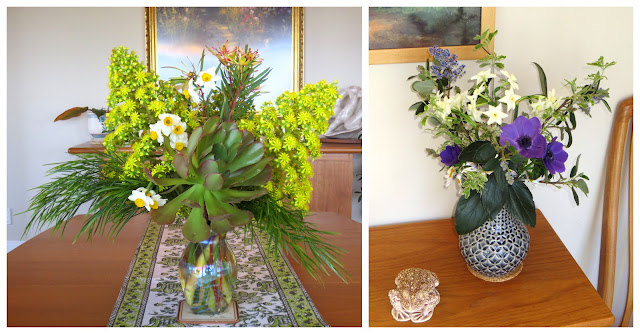I have three bird feeders outside my home office window. I left them empty during the summer and early fall months until temperatures fell. In January, the white-crowned sparrows arrived and activity at the feeders picked up. As the birds tend to fly away as soon as I go out the back door, I used a telephoto lens to capture photos from inside with mixed results.
 |
| This is the best wide shot I could get that wasn't blurred by sun glare or fog |
The white-crowned sparrows (Zonotrichia leucophrys) live in parts of the western US year-round but they're not generally seen in my area until the winter months. Unlike many of the birds here, these sparrows know how to strike a pose.
 |
| According to TheCornellLab the oldest verified age of a white-crowned sparrow was at least 13 years and 4 months |
Apparently, they'll share their territories with some birds but are known to drive others away, including Dark-eyed Juncos. I noticed Juncos hopping about for awhile but they've been noticeably absent of late. However, it doesn't seem that the sparrows have any issues with finches.
 |
| Based on casual observations, house finches (Haemorphous mexicanus) are the most common (or at least the most visible) of the small birds here |
 |
| According to Cornell, male house finches get their red color during the molting period from pigment in their food. The more pigment, the redder their plumage. |
 |
| Female house finch sharing a feeder with a white-crowned sparrow |
 |
| This is the best shot I got of a lesser goldfinch (Spinus psaltria), which is also a very common year-round resident. Lesser goldfinch males in the far west have green backs, unlike those further east (source: Cornell). |
About two years ago, I noticed another kind of finch hanging around. I know it by the common name of spice finch (Lonchura punctulata) but it's also known as nutmeg mannikin, ricebird, and scaly-breasted munia. Native to tropical areas of Asia, they spread in the US as escaped birds. They were first sighted in Cocoa Beach, Florida in 1964. They've more recently been added to Audubon's list of California State birds. In the US, they're reportedly most common in Florida and California (source: Wikipedia).
 |
| Male and female spice finches look similar, although the male's coloring is somewhat darker. Juveniles are paler in color, lack the dark head, and have buff-colored breasts. |
Originally, spice finch sightings were one-off observations. This year I've seen these birds hanging out in noticeably larger groups but they also seem to get along fine with house finches, lesser goldfinches, and white-crowned sparrows.
 |
| Spice finches sharing space with a single lesser goldfinch. This feeder with an outer cage seems to be the favorite among the small birds. |
 |
| I noticed that the spice finches often share feeding perches, something I've never noticed among the other birds |
 |
| Good view of a juvenile spice finch on the right |
The California scrub jays (Aphelocoma californica) send all the small birds packing when they visit but, thankfully, they don't stop by often.
 |
| Not a great photo but a very interesting, if common, bird. Like it's relative the crow, it's very clever. Although its weight can close the seed portals of this "squirrel buster" feeder, it can balance its weight in such a way as to get some seed, even if he can't keep it up long. |
At least the scrub jays don't break the feeders. The same can't be said of the squirrels.
 |
| On the left is the squirrel contemplating his leap onto the "squirrel buster" bird feeder. The weight he (or she) put on the cage surrounding the feeder immediately closed the seed portals as shown on the right. With practice, they learn to hang upside down from the top of the feeder to avoid closing the portals immediately but they've actually broken the springs in some of these feeders. |
 |
| The squirrels are currently leaving the bird feeders alone, having found another source of food elsewhere in our garden. The already paltry crop of oranges shrinks more every day. |
Meanwhile, my cat Pipig and I had our sixth visit with the vet since November earlier this week. She continues to improve but still hasn't received an all-clear report; however, absent a new problem, we don't plan to see the vet again for another four months. She's eating well but her weight is still stuck at six pounds, fourteen ounces.
Have a nice weekend.
All material © 2012-2024 by Kris Peterson for Late to the Garden Party





















































